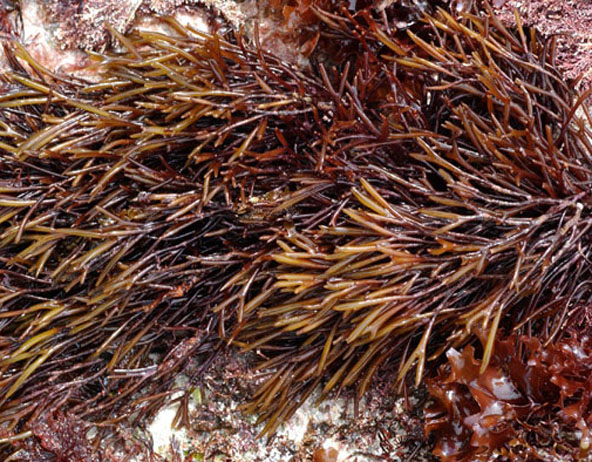
A 1959 publication, Furcellaran, a Versatile Seaweed Extract, indicates the history that led to the development of furcellaran which resulted from the allied nations being cut off from Japanese agar during WWII. http://link.springer.com/article/10.1007%2FBF02885668#page-1
Source
Furcellaran is extracted from the red alga Furcellaria lumbricalis, previously known as F. fastigata. The alga grows along many coasts of the North Atlantic and its adjacent seas, particularly in Kattegat, between Denmark and Sweden. The majority of the harvested species comes from Denmark and Canada, as noted at the Seaweed Industry page:
https://seaweedindustry.com/seaweed/type/furcellaria-lumbricalis
However, according to a 2005 article in the Journal for Applied Phycology, the resources in Denmark are in decline, while still being abundant in Estonia. http://link.springer.com/article/10.1007%2Fs10811-005-1635-2#page-1
Structure
CAS Registry Number: 9000-21-9
According to the CRC Handbook of Food Additives, the molecular weight of furcellaran is believed to be 20,000 80,000.
The structure is similar to carrageenan in that it has both a kappa gelling and a lambda non-gelling components. The gelling fraction is potassium sensitive, as for carrageenan. However, furcellaran has a lower sulfate content than carrageenan. Marine Polysaccharides: Food Applications list sulfate content for furcellaran at 12-16%, while for agar the number is below 4.5%.
Furcellaran is composed of D-galactose (46-53%), 3,6-anhydro-D-galactose (30-35%) and sulfated portions of both of those sugars (16-20%).
The structure of furcellaran is similar to that of k-carrageenan. The essential difference is that k-carrageenan has one sulfate ester per two sugar residues, and furcellaran has one sulfate ester for every three to four sugar residues.
A comparative drawing of the structure of furcellaran and carrageenan is provided by an Estonian producer, Est-Agar AS. http://www.estagar.ee/furc.html The structure of the Estonian furcellaran was examined and published in the Journal for Applied Phycology: http://link.springer.com/article/10.1007%2Fs10811-005-1635-2#page-1
Claiming that alkali treatment degrades polysaccharides, the article compares native furcellaran to both alkali modified and commercial furcellaran. (The content can be viewed online).
More on structure can be found here:
Production methods
The FAO Document Repository highlights the method described by Whistler (1973):
The washed Furcellaria is pretreated in concrete tanks with an alkaline solution for 2-3 weeks. The material is then boiled in water and the extract is obtained by filtration and centrifugation, subsequently concentrated by vacuum vaporization and precipitated as gelled threads by a solution of potassium chloride. The threads are drained and frozen in a brine freezer for 20-30 hours. After thawing in a potassium chloride solution, the gel precipitate is pressed or centrifuged into a fibrous substance containing about 15% dry mass. The material is dried, ground and sifted to produce a powder.
http://www.fao.org/docrep/005/ac860e/AC860E02.htm
According to Marine Polysaccharides: Food Applications, the product is a potassium salt of this polysaccharide containing 8-15% KCl.
As alkali treatment degrades polysaccharides, a detailed description of a water extraction method is prowided in the Journal for Applied Phycology.
http://link.springer.com/article/10.1007%2Fs10811-005-1635-2#page-1
Properties
The gelling properties are intermediate to agar and carrageenan. Some of the qualities are described in the CRC Handbook of Food Additives. According to the guide, furcellaran is soluble in water at about 75-77 degree C, as well as in boiling milk, and forms firm, smooth, relatively elastic gels in both media. Concentrations of up to 3% are dispersible in water. Solutions are quite viscous at certain temperatures. The viscosity of 1.5% dispersion will increase on heating at about 37C, reach maximum at 43C and decrease with further heating. Upon cooling, viscosity gradually increases until the gelling point is reached. Solutions can be autoclaved for several hours without degrading, but degradation occurs on heating under acidic conditions. Furcellaran forms gels on heating and cooling to about 40-45C. A 1% gel exhibits very little hysteresis, forming and melting between 35-45C but higher concentrations melt at higher temperatures than the gelling point. Gels are quite firm, similar to agar in strength and stronger than carrageenan, but like carrageenan, gel strength is increased by the presence of potassium ions, and gel texture modified by the addition of locust bean gum. Furcellaran gels are more elastic than either agar or carrageenan. Gel strength is pH dependent, reaching maximum at pH 8.Gelling ability may be destroyed or decreased by heating at low pH.
The properties of furcellaran are evaluated in Industrial Gums: Polysaccharides and their Derivatives. Solubility, viscosity and gelation are discussed. It is mentioned that furcellaran gels will incorporate a great variety of ingredients, such as salts, acids, sugar and protein, which all influence the gelling properties.
FAO provides information derived from furcellaran safety studies:
http://www.inchem.org/documents/jecfa/jecmono/v19je05.htm
Use
Natural colloid, gelling agent, viscosity control agent primarily in food products but also in pharmaceuticals; also in diabetic and baby food preparations, products for reducing body weight, toothpastes; as carrier for food preservatives, bactericides; in bacteriological culture media.
http://www.drugfuture.com/chemdata/furcellaran.html
A notable feature is the successful combination of furcellaran with other gums or thickening agents such as carrageenan, locust bean gum, guar gum and sucrose, to produce gelling products with special properties. http://www.fao.org/docrep/005/ac860e/ac860e02.htm
According to the Industrial Gums: Polysaccharides and their Derivatives, 90% of furcellaran is used in food products, the remaining amount in the pharmaceutical and cosmetic industry. The applications in pharmaceutical products and cosmetics are the following: suspensions, emulsions and foams; also disintegration in tablets.
Hydrolyzed furcellaran (CAS No 73297-69-5) described by the INCI directory as the hydrolysate of furcellaran derived by acid, enzyme or other form of hydrolysis. It is classified as skin protecting.
http://www.specialchem4cosmetics.com/services/inci/ingredient.aspx?id=17096
Novel application in encapsulation
http://www.foodnavigator.com/Science-Nutrition/Seaweed-bead-to-offer-novel-encapsulation-potential
In this 2007 article, furcellaran has been named as a material for encapsulation of bioactive compounds into beads, protecting them against degradation.
Patents
A list of patents associated with the use of furcellaran can be found here:
http://www.specialchem4cosmetics.com/services/search/searchsite.aspx?q=furcellaran
(quite a few, didnt have a chance to review them show various specific applications)
Other
Furcellaran and furcellaran-bovine serum albumin films are being developed to improve food quality and safety.
An article on the interaction between furcellaran and bovine serum albumin has been published by Laos Katrin. http://www.openthesis.org/documents/Interactions-between-furcellaran-globular-proteins-596700.html